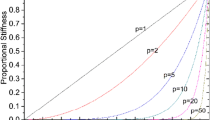Abstract
The modeling and optimization of welding spots have great effects on the stiffness performance of vehicles. To improve the traditional one-dimensional linear models that may lead to severe underestimation of the strain energy of welding spots, this paper proposes a multidimensional strain energy estimation model that considers the welding spots and adjacent elements as a whole and includes three principal stress directions. The model is verified by a U-shaped sample test. Based on the model, a method for evaluating welding spot contributions is constructed and applied to a light bus to optimize the positions of the welding spots of the body-in-white (BIW). After eight iterations of optimization, with the same number of welding spots, the frequencies of the first and second modes of the BIW are improved by 5.1% and 3.4%, respectively, while the static torsional stiffness and bending stiffness are increased by 3.2% and 1.2%, respectively.














Similar content being viewed by others
Data availability

References
Junqueira DM, Silveira ME, Ancelotti AC (2018) Analysis of spot weld distribution in a weldment-numerical simulation and topology optimization[J]. Int J Adv Manuf Technol 95(9-12):4071–4079
Pashazadeh H, Gheisari Y, Hamedi M (2016) Statistical modeling and optimization of resistance spot welding process parameters using neural networks and multi-objective genetic algorithm[J]. J Intell Manuf 27(3):549–559
Yamaguchi A, Wakana G, Obayashi K et al (2008) Spot-weld layout optimization for body stiffness by topology optimization[C]. Sae World Congress & Exhibition
Wang LS, Leiva JP, Basu PK (2003) Design optimisation of automobile welds[J]. Int J Veh Des 31(4):377–391
Lü YN, Lü ZH (2010) Multi-domain synthetic topology optimization method for automotive body spot weld layout design[J]. Chin J Comput Mech 27:648–654
Yang JK, Ye YT, Peng Q, Wu SR, Guo J (2011) Application of spot weld model using solid element in simulation of front longitudinal beam crash[J]. J Jilin Univ (Eng Technol Ed) 41(6):1542–1548
Salvini P, Scardecchhia E, Demofonti G (1997) A procedure for fatigue life prediction of spot welded joints[J]. Fatigue Fract Eng Mater Struct 20(8):1117–1128
Salvini P, Scardecchia E, Vivio F (1997) Fatigue life prediction on complex spot welded joints[J]. SAE Trans:967–975
Radaj D (1989) Stress singularity, notch stress and structural stress at spot-welded joints[J]. Eng Fract Mech 34(2):495–506
Song HS, Chen ZY, Yang N, Yang CH, Shi WK (2020) Research on the analysis method of welding spot layout robustness based on sensitivity ranking[J]. Automot Eng 42(12):1751–1757
Song HS, Yang N, Yang CH, Chen ZY, Shi WK (2020) Research on sensitivity evaluation method based on spotwelds-adjacent elements integrated strain energy[J]. Automot Eng 42(6):820–825
Bhatti QI, Ouisse M, Cogan S (2011) Cogan. An adaptive optimization procedure for spot-welded structures[J]. Comput Struct 89(17-18):1697–1711
Brozek M (2015) Resistance spot welding of steel sheets of different thickness[J]. Eng Rural Dev 14:72–77
Ouisse M, Cogan S, Guillaume B (2006) Towards a robust optimization of spot weld design in automotive structures. proceedings of isma
Ouisse M, Cogan S (2010) Robust design of spot welds in automotive structures:a decision-making methodology[J]. Mech Syst Signal Process 24(4):1172–1190
Mirzaei F, Ghorbani H, Kolahan F (2017) Numerical modeling and optimization of joint strength in resistance spot welding of galvanized steel sheets[J]. Int J Adv Manuf Technol 92(9):3489–3501
Zhang Y, Taylor D (2001) Optimization of spot-welded structures[J]. Finite Elem Anal Des 37(12):1013–1022
Lü YN, Lü ZH (2009) Effects of spot weld connecting models on the prediction accuracy of structural stiffness by finite element analysis[J]. Eng Mech 26(10):171–176
Palmonella M, Friswell MI, Mottershead JE, Lees AW (2005) Finite element models of spot welds in structural dynamics: review and updating[J]. Comput Struct 83(8-9):648–661
Chen W, Deng X (2000) Performance of shell elements in modeling spot-welded joints[J]. Finite Elem Anal Des 35(1):41–57
Han SH, An DG, Kwak SJ, Kang KW (2013) Vibration fatigue analysis for multi-point spot-welded joints based on frequency response changes due to fatigue damage accumulation[J]. Int J Fatigue 48:170–177
Ding JF, Han ZY, Ma XR (2010) Finite element model verification strategy of large complex spacecraft[J]. J Astronaut 31(2):547–555
Funding
This work was supported by the National Key R&D Program of China (2018YFB0106200).
Author information
Authors and Affiliations
Contributions
Not applicable
Corresponding author
Ethics declarations
Ethics approval
Not applicable
Consent to participate
Not applicable
Consent for publication
The author confirms:
That the work described has not been published before (except in the form of an abstract or as part of a published lecture, review, or thesis)
That it is not under consideration for publication elsewhere
That its publication has been approved by all co-authors, if any
That its publication has been approved (tacitly or explicitly) by the responsible authorities at the institution where the work is carried out
The author agrees to publication in the Journal of Advanced Manufacturing Technology and also to publication of the article
The author warrants that his/her contribution is original and that he/she has full power to make this grant. The author signs for and accepts responsibility for releasing this material on behalf of any and all co-authors. The copyright transfer covers the exclusive right to reproduce and distribute the article, including reprints, translations, photographic reproductions, microform, electronic form (offline, online), or any other reproductions of similar nature.
After submission of the agreement signed by the corresponding author, changes of authorship or in the order of the authors listed will not be accepted.
Competing interests
The authors declare no competing interests.
Additional information
Publisher’s note
Springer Nature remains neutral with regard to jurisdictional claims in published maps and institutional affiliations.
Rights and permissions
About this article
Cite this article
Song, H., Yang, C., Yang, N. et al. Research on a multidimensional strain energy estimation method for welding spots based on performance optimization. Int J Adv Manuf Technol 117, 1263–1273 (2021). https://doi.org/10.1007/s00170-021-07724-w
Received:
Accepted:
Published:
Issue Date:
DOI: https://doi.org/10.1007/s00170-021-07724-w



